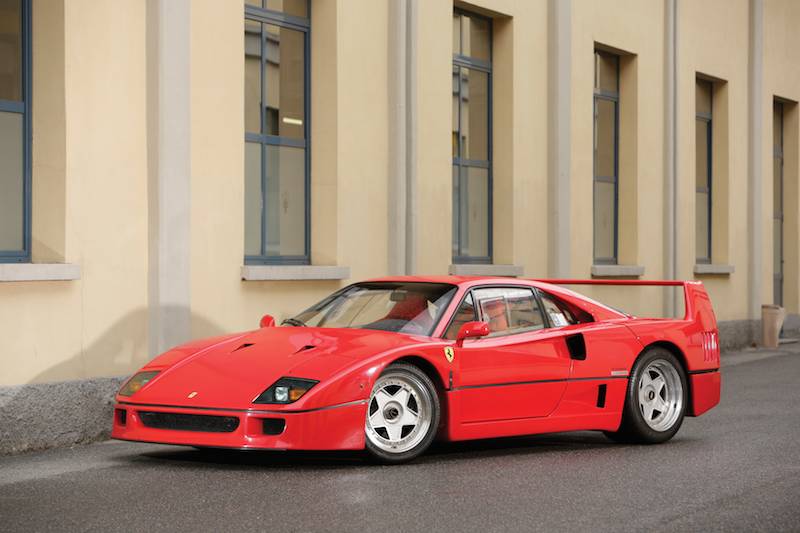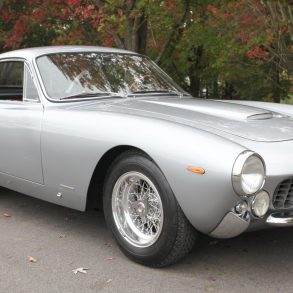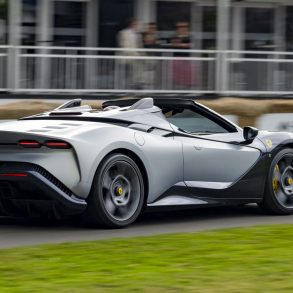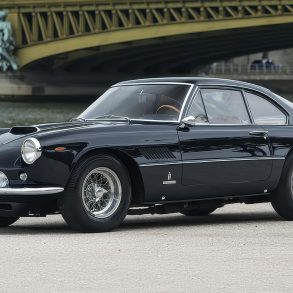The Ferrari F40 drove along the path of its predecessor, the Ferrari 288GTO, and became the second Ferrari with a limited number of manufactured units.
Thanks to its bombastic appearance, demanding driving characteristics, and racing technology, it instantly became the most desirable supercar and overshadowed the other supercars of the era which included the Porsche 959, Lamborghini Countach and his brother Ferrari Testarossa.
The fact that the Ferrari F40 remains one of the most brutal and iconic supercars even to this day was no coincidence.
The F40 was inspired by the flourishing 1980s B-Group Rally class scene which was known for its brutality and zero-nonsense engineering. Zero-nonsense is the perfect term to describe the Ferrari F40, just pure automotive bliss. Here is how the F40 earned its status from day one.

The Birth of the Ferrari F40
In 1985, Porsche stunned the public at the Frankfurt Motor Show with the introduction of the 959 concept. With a turbocharged six-cylinder engine, it had 50 horsepower more than its current rival Ferrari 288 GTO and a 15 km/h higher top speed. It became the fastest production car in the world. But that wasn’t all, along with smart four-wheel steering and adjustable suspension, Ferrari was easily pushed into second place.
Giovanni Razelli, the director of Ferrari at the time, did not sit idly, he immediately approved the development of an even faster supercar- the F40. The designated number 40 came from the fact the car was released to celebrate Ferrari’s 40th anniversary (Ferrari 125 was created in 1947).
In 1987, 89-year-old Enzo Ferrari showed the new F40 for the first time in Maranello. Unfortunately, one of the greatest automotive personas died the following year, and the F40 went down in history as the last model approved by Enzo himself.

Brutal from the Ground Up
The F40 was developed from the experimental model GTO Evoluzione, a racing version that was discontinued after the collapse of the famous Group B rally.
They retained the tubular structure, but the exterior was made out of materials that were then available in Formula 1. The body was made exclusively out of carbon fiber, Kevlar and Nomex refractory material. The floor, roof and doors were made of composite materials. This increased the body stiffness by 20 percent.
From the beginning, Ferrari treated the F40 like a race car and removed as many unnecessary elements as possible. The greatest emphasis was on the weight, which had to be as low as possible.
The rear and side windows were made of plexiglass, the mechanical displacement of the windows was removed, the Spartan passenger cabin was free of air conditioning, radio, passenger glovebox compartment, leather seats, carpets and sound insulation. They even removed the door panels and hooks. The bare door was adorned only by a steel rope with whom you opened the door.

The completely raw carbon fiber surfaces were completely open, exposed and raw. Viewed directly, the 288GTO was designed as a prestigious vehicle to pamper its occupants, and the F40 was a narrowly focused racing model that wowed purists with non-adjustable carbon-fiber shell seats, a small Momo steering wheel and aluminum pedals.
Taking the Race Car to the Road
The F40 had no sophisticated technology installed like the Porsche 959. It was a classic Ferrari, closer to a racing formula than a conventional vehicle. With a central engine layout and a weight ratio being close to 50:50, it was a real rear-wheel-drive rocket. They were also minimalist on the chassis. The Koni adjustable suspension was the only “prestigious” accessory. The steering wheel had no power steering and the braking system had no ABS. Mass was saved by removing vacuum pumps and a complex hydraulic system. The low center of gravity, along with the lightweight design, brought a departure from Porsche’s philosophy.
We could add a page of long technical specifications at this point, but we will pick just a few extremely stunning ones. The weight eventually stopped at just 1,100 kg. Most of the weight was caused by the eight-cylinder twin-turbo engine with 32 valves. The engine was taken from the GTO model but had an increased displacement of 2,936 ccs and a higher engine pressure ratio (1.1 bar). It generated 352 kilowatts of power (478 horsepower) at 7,000 rpm and 577 newton meters of torque.

The IHI turbochargers were cooled by a pair of Behr refrigerators and electronic fuel injection was provided by Weber-Marelli – the same components as in the Formula 1 race car. It was the first car in the world to exceed 200 miles per hour – 324 km/h. Ferrari also offered the optional non-synchromesh sports gearbox for those who wanted the full race car experience.
Technicals and Specifications
| Specification | Ferrari F40 |
| Top Speed | 201 mph |
| Acceleration | 0-60mph 4.7 seconds |
| Engine Location | Rear, in-line |
| Configuration | Twin turbocharged V8 |
| Bore and stroke | 82 x 69mm |
| Capacity | 2936cc |
| Horsepower | 478bhp @ 7000rpm |
| Valve Operation | Twin overhead campshafts per bank |
| Drive | Four wheel |
| Transmission | Manual five-speed |
| Chassis | Tubular steel, kevlar and carbon fibre |
| Suspension- front | Wishbones and coil spring |
| Suspension- back | Wishbones and coil spring |
| Brakes | Ventilated discs |
Ferrari 70 Years – Book from Amazon
Designed for Speed
The Ferrari F40 was the first production car to use mainly composite body materials. The entire body was made out of 11 panels. This was made possible by the large front and rear single panel units.

The large rear panel lifted up which allowed easy access to the engine. The exterior design was made by the legendary Pininfarina studio, more specifically Leonardo Fioravanti. There is a famous quote by Fioravanti that remains relevant to this day: “What we have done with the F40 is to build a machine which pays little respect to the limitations of modern times… This car, for us, has a special meaning. This world has too many computers, too much technology and here we have recovered the design of a car as an emotion, just as in the old days. It is not nostalgia, but we prove that even today it is possible to make a car with a human approach.” The F40 features one of the most recognizable shapes which is the rear “wing” that is aligned with the sides of the car.

The standard wheels were five spoke Speedline rims with a single nut to a Rudge hub. The Pirelli P Zero tires were made specifically for the Ferrari F40. Behind the wheels, was a set of large cross-drilled ventilated disc brakes.

You could order any color you wanted, as long as it was red. The car was offered red with red bucket cloth-covered seats on the inside.
No-nonsense Interior
The interior could not have been any more simple. The performance of the F40 demanded it. Red racing seats, a small Momo racing steering wheel and a felt-covered dashboard and central funnel. There was no interior trim, just plain or painted composite materials shaped to serve their function. Forget about comfort items like electric windows, all you got was simple manual winders or even sliding panels if you bought early series cars. The floors were uncarpeted, featuring uncovered composite materials. In front of the driver was a set of drilled aluminum pedals that looked like they came straight from a race car.
The bare, minimalist interior allowed the driver to focus on driving. It also accentuated the feeling that you were inside a race car for the road. The F40 was a machine meant for driving, not relaxing and cruising along the French riviera.
The Ferrari F40 LeMans and Competizione
According to Enzo Ferrari, the F40 was never meant to go on a racetrack. But it was bound to happen, and it did. Thanks to lobbying by Daniel Marin, an associate of the french Ferrari importer company Charles Pozzi SA, the Ferrari F40 got its chance on the racetrack. He convinced Ferrari to let Michelotto of Padova produce a series of race car variants of the F40. These racing versions of the F40 adhered to the International Motor Sports Association rules.
The Ferrari F40 LM (short for LeMans), believe it or not, was even more exciting, exotic, and extreme than the ordinary F40. The specially prepared engine produced 720 horsepower, meaning it could go from 0-60 mp/h in just 3.1 seconds. The top speed was 230 mp/h (380 km/h) and it was absolutely astonishing. To improve aerodynamics, they fitted the F40 LM with a more aggressive body kit that added even more downforce. To maximize the downforce on the racetrack a track orientated front and also a rear wing was developed and fitted. They also added wider wheels, better brakes, suspension and an enhanced gearbox. The LMs interior was even more stripped down. The front flip-up headlights were replaced by fixed headlights behind Lexan covers.

Ferrari felt that the LeMans name was too narrow-minded and decided to rename the F40 LM into the more traditional Ferrari F40 Competizione. Only 19 Ferrari F40 LM/Competizione were ever built by Michelotto which makes them one of the most desired and collectible supercars today.

F40s Life on the Race Track
The first F40 LM competition appearance was in 1989. It debuted in the Laguna Seca Raceway round of the IMSA. It appeared in the GTO category and was driven by Jean Alesi. The Ferrari F40 LM Evolution finished third while still beating some of the events regular dominators. In the next season drivers like Jean-Pierre Jabouille, Jacques Laffite and Hurley Haywood achieved three second and one third place as their best results
The F40 did not return to IMSA for the following season but it still spent time on the track in the hands of private owners. The F40 appeared in numerous domestic GT series events, including the JGTC. The F40 LM was a winner at the 1994 4 Hours of Vallelunga. This was the F40s first international racing appearance and the first appearance in the BPR Global GT Series by Strandell.
In 1995, four F40 were independently developed by Pilot-Aldix Racing (F40 LM) and Strandell (F40 GTE, racing under the Ferrari Club Italia banner). The F40 GTE ended up winning the 4 Hours of Anderstorp. The F40 repeated the Anderstorp win in 1996.
Ultimately the F40 was no longer a match to the new McLaren F1 GTR and was not seen in GT racing in later years.
Production of the Ferrari F40
Just like the Ferrari 288 GTO, the F40 was meant to be a limited production car. Ferrari planned on making just 400 of them but Ferrari quickly changed their mind once they saw the demand for the F40 being much bigger than expected. A new Ferrari F40 would cost $400,000 in 1987, which roughly translates into 900,000 in today’s money. This was 5 times as much as the predecessor 288 GTO. In the end, 1315 Ferrari F40’s were manufactured with 213 of them reaching the USA.

Prices of the Ferrari F40 have soared over the last years. But as with all iconic Ferrari models, history, condition and mileage also play a decisive role in the price. On August 7th, 2020, Gooding & Company held it inaugural geared online auction where a 1992 Ferrari F40 sold for $1,628,000. The Ferrari F40 LM was sold in 2019 for a staggering $5.5 million. The price is expected to grow in the future as people begin to realize the automotive world will never see anything like the F40 again.
A great example of Ferrari F40 suitable for an astute collector is this 1992 F40, one of only 20 that arrived in the US during the final year of production.

With a late January 1992 build date, this stunning FCA Platinum awarded Ferrari F40 was delivered to California dealer, Ogner Motorcars Inc, in Woodland Hills, California. It was later presented to its first owner in January 1993. After many shows and years, the F40 first changed hands in 2002 with only 5932 miles having been accumulated.


More information regarding this exceptionally rare model year F40, that has now only accrued 9618 miles, may be found at Milestone Motorcars LLC.
“I expressed my wish to the engineers—build a car to be the best in the world. And now the car is here.”
Enzo Ferrari
The Ferrari F40 was and will forever be special. The sheer brutality and rawness of the F40 is something we will never experience again due to safety standards.
There are several factors that contribute to the F40 legendary status. Appearance, steering, the brutal exhaust note, the stripped interior, and speed are just some of them.
The F40 was never really designed to be a grocery-getter and this is what the majority of the press failed to realize back in 1987. The writer of Autocar magazine, Mel Nichols, put it best: “I do not yet know whether the F40 is tractable in traffic, fearsome on the wet, harsh on bumpy roads or too noisy on long journeys. It has no luggage space and getting in and out is awkward. But I do know this: on a smooth road it is a scintillatingly fast car that is docile and charming in its nature; a car that is demanding but not difficult to drive, blessed as it is with massive grip and, even more importantly, superb balance and manners. You can use its performance, the closest any production carmaker has yet come to race car levels, and revel in it.”
In 2020 this statement still holds, no car since has been more race orientated and still road legal, securing the Ferrari F40 its iconic status.











